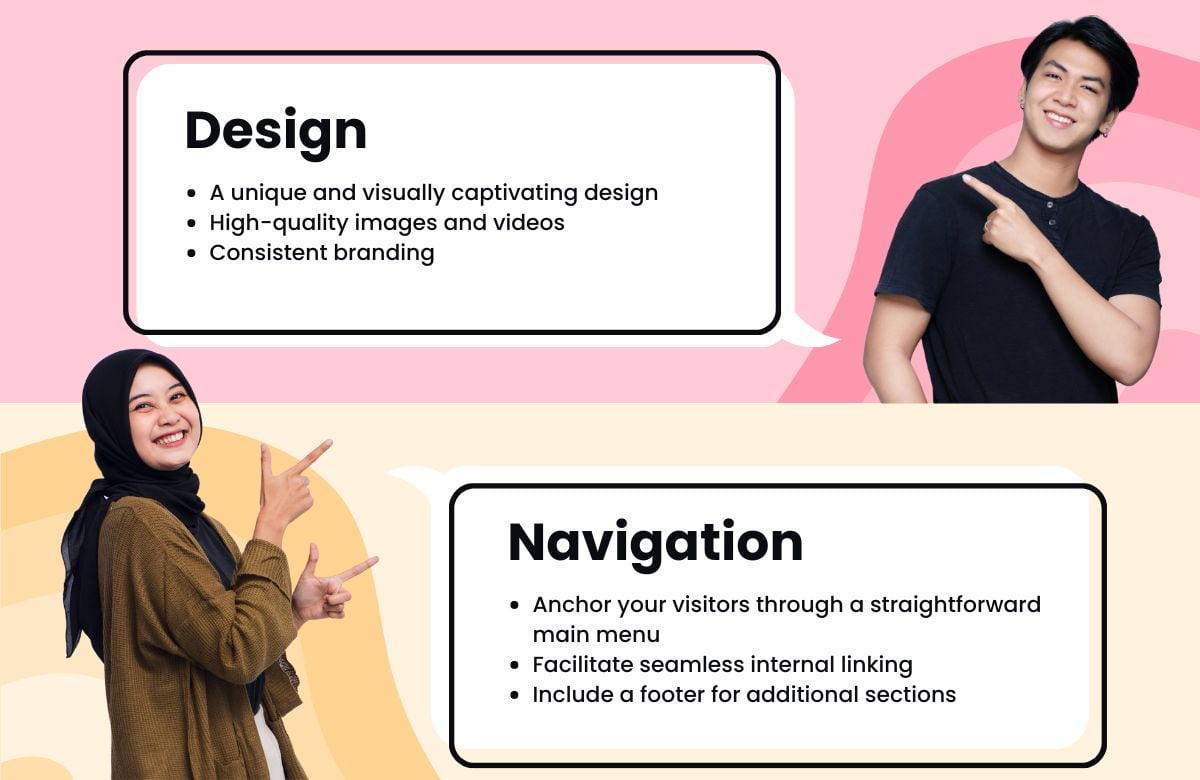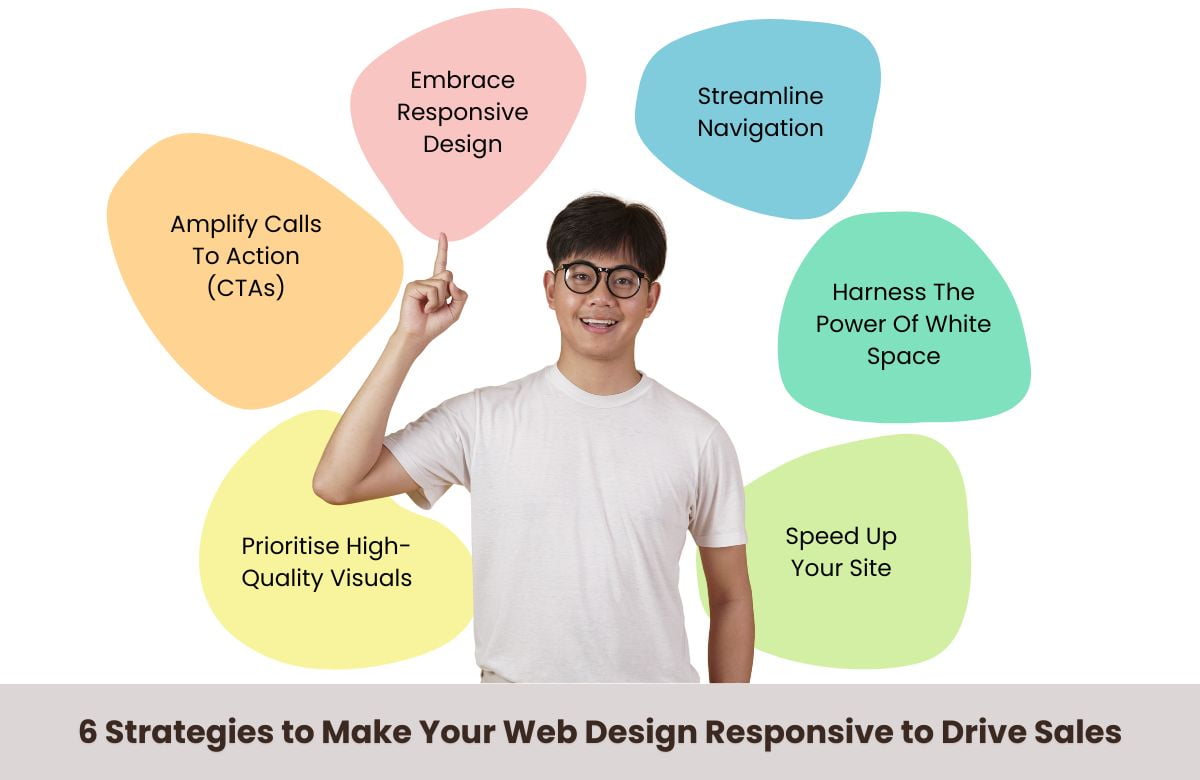Every business owner aspires to enhance their sales figures. Each successful conversion, representing the desired action you want your website visitors to take, brings you closer to achieving higher sales. While your website may already generate online leads, Consistent revenue growth is essential for your business. The good news is that simple adjustments to your website’s design can improve conversion rates and increase sales. A well-optimized website design not only attracts more visitors but also guides them seamlessly towards completing desired actions.
Forrester, a well-known research institution, conducted a study titled The Business Impact of Design that revealed a remarkable statistic: over 600 business leaders found that companies investing in design have a 218% higher return on assets than those not. Conversion rate optimization (CRO) offers a strategic approach to strengthening website elements, such as UX, intending to generate greater profits.
In this blog post, we delve into the best practices of web design for conversion rate optimization, which are much simpler than you might think!
Research indicates that 96% of website visitors are not yet prepared to purchase. Consequently, your website must guide your audience towards a potential sale through its content and user experience. Achieving this requires outstanding design and seamless navigation to engage your website visitors.
By employing proven CRO techniques, you can significantly enhance the results your website achieves. To create a high-performing sales funnel, all conversion points on your website pages must align with broader digital marketing and search engine optimization (SEO) strategies. These strategies are indispensable for increasing your website’s discoverability and tailoring your message to your target audience. Therefore, having a professionally designed website is essential for transforming it into a highly effective digital asset for your business. Make sure your website is optimized for both search and conversions.
How Does Website Design Affect Sales?
We are all aware of the significance of website design. We desire websites that make us proud and leave a positive impression on potential customers. However, the influence of website design on sales and overall success goes far beyond mere aesthetics.
A well-crafted website has the potential to significantly boost conversion rates, while a poorly designed website can become a hindrance to business success.
Page Load Speed: A Critical Factor For User Experience
A significant aspect of website speed is users’ patience regarding loading times. According to Google, 75% of users consider page load speed the most crucial factor affecting their overall experience, especially for mobile devices users. Google’s research on 900,000 mobile websites reveals an average load time of 22 seconds. Considering that 53% of users abandon a mobile site that takes more than 3 seconds to load, the potential loss of customers is substantial.
The Cost Of Slow Websites: Billions In Lost Sales
Website speed is often overlooked, but it is a critical factor in both web design and business success. Slow-loading websites can frustrate users and lead to lost sales. In fact, a study by Google found that 53% of mobile users will abandon a website if it takes longer than 3 seconds to load. This means that a slow website can also cost a business a significant number of potential customers. This means that a slow website can cost a business millions of dollars in lost sales each year.
There are a number of factors that can contribute to slow website speed, such as large image files, too many redirects, and unoptimized code. However, there are also a number of things that businesses can do to improve their website’s speed, such as using a content delivery network (CDN), optimising images, and minifying code.
By investing in improving their website’s speed, businesses can reap significant rewards. A faster website will provide a better user experience, which can lead to increased sales and conversions. Additionally, a faster website will rank higher in search engine results pages (SERPs), which can lead to more organic traffic.
First Impressions: 94% Hinge On Website Design
According to Webfx, a staggering 94% of a customer’s initial impression of a business, when found online, is shaped by the design of its website. This statistic emphasises businesses’ control over website design and highlights the potential for a significant improvement in customer perceptions through website redesign.
Lightning-Fast Decision-Making: 0.05 Seconds To Impress
Research cited in the Journal of Behaviour and Information Technology reveals that users take a mere 50 milliseconds (0.05 seconds) to form an opinion about a website. Users make this critical judgement before they can read more than a few words of content, primarily evaluating design, layout, and clarity. This rapid decision-making process determines whether a visitor stays on your site, makes a purchase, or moves on to a competitor.
SEO Malaysia And Search Rankings: Design’s Impact On Visibility
Search Engine Journal highlights that page experience, page speed, on-page optimization, and mobile-first design constitute four of the top seven Google ranking factors, accounting for approximately 57%. If a website’s technically deficient design, it will likely rank lower in search listings, leading to reduced discoverability, fewer customers, and diminished sales.
Credibility At Stake: 75% Of Consumers Judge By Design
Businesses that neglect their website compromise their corporate identity and customers’ perceptions of their brand and products. Kinesis reveals that 75% of consumers assess a company’s credibility based on its website design. This underscores consumers’ importance on the web experience and its role in shaping brand and product perception. Consumers actively gauge a company’s ability to deliver quality services or products based on its website design. This is a critical lesson for businesses, illustrating that poor website design can undermine their reputation and capacity to deliver quality.
Mobile Accessibility: The Key To Retaining Users
Recent discussions about mobile-responsive web content emphasise that businesses must create responsive websites. Google’s research reveals that 61% of users are unlikely to return to a mobile device they found difficult to access, with 40% opting to visit a competitor instead and failing to design websites for mobile accessibility, resulting in lost customers directed to competitors with responsive websites.
Enhancing Website Conversions With SEO Strategies
The COVID-19 pandemic has accelerated the shift towards online platforms for consumers. This fundamental change in global consumer behaviour means more people search for products and services online. This shift in mindset is expected to persist even after the pandemic, underscoring the importance of establishing a strong online presence for your business.
Consider this: Google processes a staggering 40,000 searches every second. Without a robust SEO strategy, your website may remain invisible in the vast online landscape. Disconnection between your business and potential customers can result in missed sales opportunities.
Nasar Khan, a seasoned SEO Malaysia expert at iMarketing, shares valuable insights on how to enhance website conversions:
- Streamlined site structure and well-organised information architecture to prevent users from leaving your site.
- Mobile-friendly and responsive design to achieve higher rankings on search engines.
- Exceptional usability to keep users engaged on your site.
- User-friendly site design for precise and compelling message communication.
- Optimised images for increased relevance and faster loading times.
- Comprehensive web design optimization for maximum site speed.
- Conversion-focused web design to guide visitors towards desired actions.
These SEO techniques enhance the discoverability of your site and attract more users. However, as Nasar emphasises, what truly drives sales are the conversion points within your responsive website design.
What Does Conversion Rate Optimization Entail?
Establishing a strong SEO foundation is crucial for driving organic website traffic to enhance conversion rates. When your website experiences a high volume of traffic but few actual conversions, it becomes imperative to implement alterations to your web design to elevate the conversion rate.
Conversions encompass the specific actions you desire your website visitors to take, and this doesn’t always equate to making a purchase. For instance, in business-to-business (B2B) companies, conversions involve scheduling a meeting with a sales representative. The conversion rate, in turn, represents the proportion of website visitors who successfully perform these desired actions. This metric holds paramount significance as it gauges the effectiveness of your website in attracting and engaging qualified leads for your business. By formulating a targeted strategy to enhance conversion rates, you’re taking a substantial stride towards amplifying your sales.
Conversion rate optimization (CRO) revolves around mitigating friction across all website elements and ensuring that your digital strategy offers genuine value to your intended audience. While it can be applied to paid advertising strategies, its primary focus within web design is transforming website visitors into loyal customers. In essence, conversion rate optimization in web design entails the creation of a visually appealing website centred on both sales and conversions, effectively guiding qualified leads towards conversions on the site.
How Conversion-Oriented Website Design Enhances Your Sales

To fully grasp the impact of web design on your revenue potential, it’s essential to comprehend two key concepts: User Interface (UI) and User Experience (UX). While these terms may seem self-explanatory, a comprehensive understanding of them is crucial, as they constitute vital elements in conversion-focused web design. In simple terms, UI pertains to your website’s appearance and functionality, whereas UX encompasses the overall journey of your site visitors.
By optimising both the UI and UX of your site through innovative design and intuitive navigation, you can significantly increase your site visitors’ willingness to engage, thus enhancing your chances of converting them into customers.
Ensure that your website excels in these two critical areas:
Design
First impressions hold immense significance, and your website has a mere 50 milliseconds to make a favourable one. During this brief moment, users form opinions about your site primarily based on its visual appeal. A poorly designed homepage can negatively impact your bounce rate, representing the percentage of visitors who exit your site after viewing only one page. Your web design can persuade your audience to remain on your page. 94 % of people distrusted a website with subpar design elements. After delivering an exceptional initial impression, your web design must leave a lasting one to earn your audience’s trust and encourage further engagement with your brand.
Ensure that your web design includes the following:
- A unique and visually captivating design
- High-quality images and videos
- Consistent branding
Avoid:
- An overly complex homepage
- Blocks of text that are difficult to read
- Poor use of colours
Navigation
Your website plays a crucial role by offering a clear and user-friendly navigation bar. On desktop sites, the navigation bar typically occupies the topmost portion of your website, providing users with quick access to essential information through links to various sections of your site.
Your audience arrives at your site with numerous questions in mind. Your navigation bar must address their most pressing inquiries regarding what you sell, the value you offer, and the associated costs. These elements facilitate more accessible access to your products and services.
Robust site navigation should:
- Anchor your visitors through a straightforward main menu
- Facilitate seamless internal linking
- Include a footer for additional sections
Avoid:
- Utilising technical jargon
- Incorporating excessive steps
- Allowing slow page loading times
Enhancing Responsive Web Design To Drive Sales: 6 Strategies For Success

Now that you’ve grasped the importance of web design in boosting sales, it’s time to explore how you can optimise your website’s design to maximise conversions. Here are six actionable strategies to achieve just that:
Embrace Responsive Design:
Recognize that web design profoundly impacts sales, and a pivotal step is incorporating responsive design. This ensures your website seamlessly adapts to any device, delivering an optimal user experience. With 37% of consumers favouring mobile-responsive sites, this step is indispensable in increasing sales.
Amplify Calls To Action (CTAs):
Elevate your sales potential by making your calls to action (CTAs) highly visible on your web pages. Effective CTAs guide your audience to take the desired next steps, and if they’re inconspicuous or unclear, you risk missing out on potential sales.
Prioritise High-Quality Visuals:
Elevate your sales potential with visually appealing content. High-quality visuals are pivotal in engaging your audience and preventing them from bouncing off your site due to overwhelming text blocks. Inferior visuals can deter trust and engagement. Opt for original visuals to make a lasting impression.
Streamline Navigation:
Organised navigation is a cornerstone of effective web design. Simplify the path for visitors to find your products or services quickly, increasing the likelihood of conversions.
Harness The Power Of White Space:
In pursuing enhanced web design, remember the importance of white space. Overloading your site with information can be counterproductive, leading to distraction and overwhelm. White space provides visual clarity, focusing your audience on essential content.
Speed Up Your Site:
Slow-loading sites result in significant revenue losses. Invest in web design improvements to enhance your site’s load time. Google PageSpeed Insights can help you assess your site’s speed and provide valuable recommendations. Alternatively, consider professional page speed services for comprehensive enhancements.
Cultivating Web Design Excellence: A Pathway To Sales Success
The impact of web design on sales is undeniable, and these strategies underscore its significance. A well-designed website not only attracts visitors but also guides them seamlessly toward conversion. From strategically placed call-to-action buttons to the efficient use of white space, each element plays a vital role in enhancing the user experience and ultimately boosting more sales.
Mobile responsiveness and fast page load speeds are imperative in today’s digital landscape, where web users demand quick access and smooth interactions. Trust symbols, such as security badges and client testimonials, build credibility and foster trust, essential components in convincing potential customers to make a purchase.
By implementing these strategies and prioritizing web design that caters to your audience’s needs, you can harness the full potential of your web page as a sales-driving tool. In a competitive online marketplace, a well-designed website can make all the difference, converting prospective customers into loyal customers and ensuring the success of your business. So, invest wisely make it a quality website design, and watch as it transforms your digital presence into a sales powerhouse.




